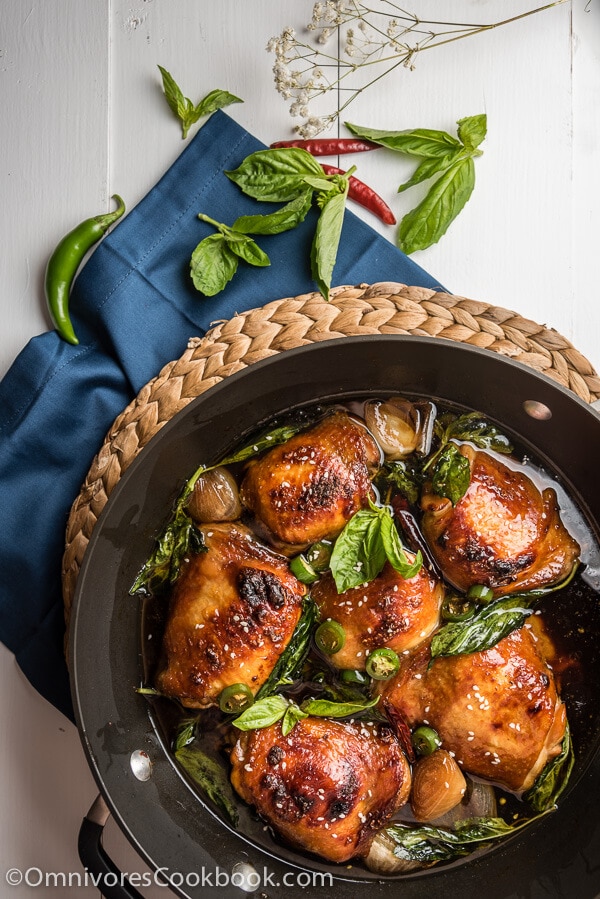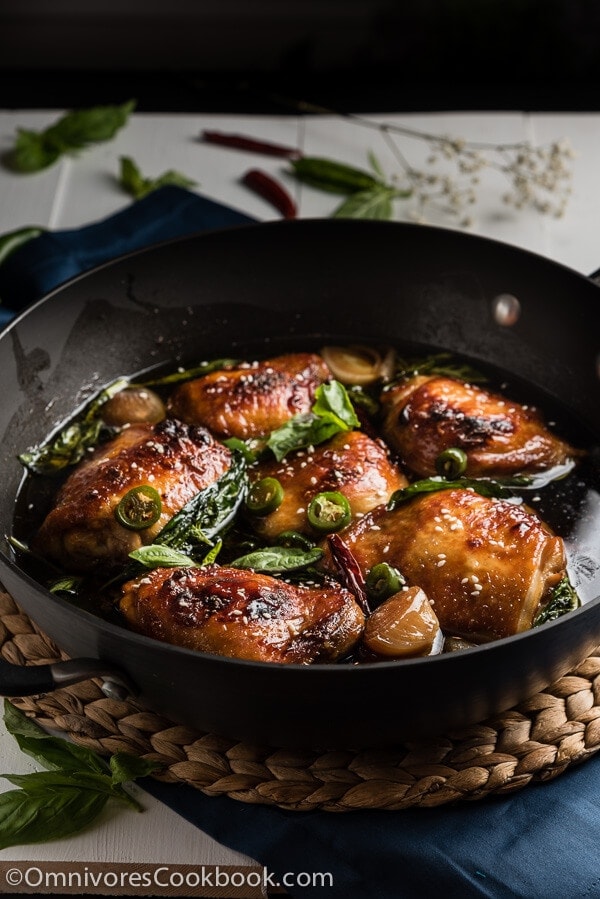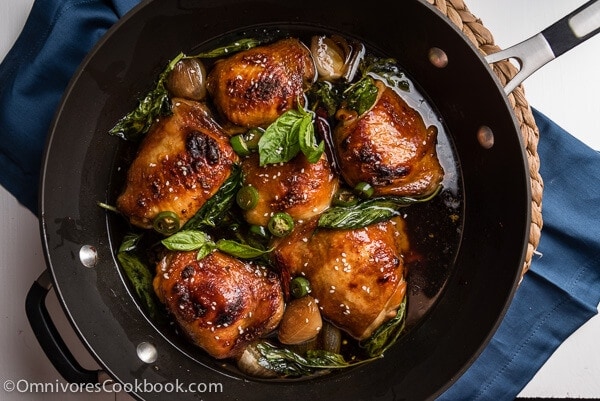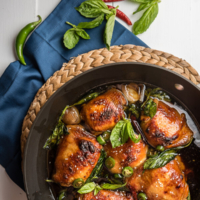
This baked Three Cup Chicken recipe lets you cook the best chicken with minimal effort. Use this method to create the most flavorful, tender, and moist chicken with crispy skin.
Three Cup Chicken (三杯鸡, san bei ji) is a famous clay pot dish that features super flavorful bone-in chicken bites with crispy skin. In addition to the Chinese flavor profile – soy sauce, cooking wine, and sugar, it uses tons of basil to create a unique and refreshing aroma that highlights the dish. Although Three Cup Chicken originated in Jiangxi, a province in southern mainland China, it has become very popular in Taiwan and is known on the mainland as a signature Taiwanese dish.
To cook Three Cup Chicken the way restaurants make it, is not easy. You need to use a whole chicken, chop it into bone-in bite sized pieces, and quickly fry it in tons of oil until crispy. The chicken is then briefly braised in a rich, sweet, savory sauce with a lot basil in a clay pot. When the dish is ready to serve, there should be no liquid remaining in the pot, just a thin layer of the rich, sticky sauce coating the chicken. The chicken absorbs tons of flavor from the braising, but remains crispy on the surface.
The reason this dish is called “Three Cup” is because the sauce calls for a cup of soy sauce, a cup of rice wine and a cup of oil. Yes, it typically requires tons of oil (no worries, though, because I’ve cut the oil in the recipe below).
To create the perfect Three Cup Chicken, there are three key elements – bone-in chicken, a well balanced sauce, and a method to produce a moist texture with crispy skin.

After examining the existing recipes, I decided to cook this dish a new way – baked. This might not look like an authentic recipe, but it helps you minimize cooking time with ingredients that are easily accessible. Even more, it cuts the process of chopping up a whole chicken. Yes, you can use skinless boneless chicken thigh and still get a delicious dish. But once you try this recipe, you’ll see how powerful it can be if you cook chicken with bones.
I guarantee you, all the most important elements of the original dish are covered in this recipe, yet it will allow you to create the best chicken with minimal effort.
I used a baking method I learned from America’s Test Kitchen, but simplified the steps. The basic idea is to submerge the chicken in the sauce and bake it at low temperature at first. This process allows the chicken skin to render its fat and the meat to be cooked slowly to achieve a moist texture. The chicken is then baked under the broiler to get the skin crispy and charred.
The recipe calls for quite a lot of sesame oil. It adds a nutty aroma to the chicken and keeps the meat moist throughout baking. The oil will be removed at the end of the cooking, along with the oil rendered from the chicken skin. Although you add 1/4 cup of oil at the beginning, you’ll remove about 1/2 cup oil at the end (Less fat and calories!).
The recipe requires 1 hour to cook, but the total time you’ll need to spend in the kitchen is about 10 minutes.
You’ll be surprised at how great the chicken turns out. The skin is nicely charred, the meat so tender and moist, bursting with the flavor of the sweet savory sauce, tons of herbs, and the aroma of the basil. It is truly addictive!

Do you like my recipes? Sign up for Omnivore’s Cookbook’s weekly newsletter to get the latest updates delivered to your inbox and a free e-cookbook! And stay connected via Facebook, Instagram, Pinterest and Google+. Thanks for reading and happy cooking!

Baked Three Cup Chicken (三杯鸡)
Ingredients
- 3 pounds (1.4 kg) bone-in skin-on chicken thighs
- 1/2 cup Japanese sake (or Shaoxing wine)
- 1/2 cup soy sauce (or tamari for gluten-free)
- 1/4 cup sesame oil
- 1 tablespoon sugar
- 1 thumb ginger , sliced
- 12 cloves garlic , peeled
- 1 big shallot , peeled and divided
- 4 dried chili peppers
- 2 cups fresh Thai (or regular basil leaves)
- 2 serrano peppers (or Thai chili peppers, sliced)
Instructions
- Preheat oven to 300 degrees F (150 C).
- Arrange chicken in a large oven-safe skillet without overlapping pieces, skin side down.
- Combine Japanese sake, soy sauce, sesame oil, and sugar in a bowl. Mix well until sugar is fully dissolved. Pour into the skillet with the chicken. Add ginger, garlic, shallot, and chili pepper.
- Bake at 300 F (150 C) for 40 minutes.
- Transfer the skillet to the kitchen counter. Flip the thighs so that skin side faces up.
- Continue baking at 300 F (150 C) for another 20 to 30 minutes, until the thickest part of the biggest thigh registers 165 degrees F (74 C). Transfer the skillet to the kitchen counter.
- Turn on broiler or turn oven to its highest temperature.
- Use a ladle to skim oil from the surface of the sauce (*see footnote 1). Add basil leaves and serrano peppers.
- Return the skillet to the oven and bake until the skin is crisped and charred, 2 to 4 minutes. Leave the oven light on and watch closely during the process. I found that baking time can vary a lot depending on the oven model.
- Transfer the skillet to the kitchen counter and let rest for 5 minutes.
- Serve over steamed rice or other preferred side with sauce while warm.
Notes
- Alternatively, you can transfer the chicken to a plate, skim the oil with an oil separator, and place the chicken back in the skillet. The oil will be removed more thoroughly this way.













this looks delish! three cup chicken is classic and I’ve been meaning to try making it for a while. thanks for the recipe!
Thanks for stopping by and leaving a comment Jenny! I’m glad you like this dish. Hope the cooking goes well and let me know how the dish turns out 🙂
Hi Maggie. I have been intrigued with this recipe since seeing it on Cooking with the NY Times site. As written, I could make no sense of how the skin would remain crisp after simmering on the stove, let alone how one would cut bone-in thighs into “bite-size pieces”! I knew that it would require cooking in the oven and probale use of the broiler. I was a bit intimidated to change the recipe drastically but now know that I was on the right thrack. Here’s the link if interested: http://cooking.nytimes.com/recipes/1017456-three-cup-chicken Thanks for making Chinese cooking so approachable especially since I need to be completely gluten free (Celiac disease). You are a genius!
Hi David, thanks for leaving a comment and I’m glad to hear you like this recipe 🙂
The way a Chinese restaurant cook and serve three cup chicken is very different from the recipe I posted here and the one on NY Times. You’re right, it’s impossible to create crispy skin after simmering the chicken.
The restaurant approach is: Chop chicken to small chucks (you need a large and thick cleaver for chopping bones, with a very sturdy cutting board. If you want to try it sometimes, try to use wings and cut them crosswise. Thighs are very difficult to chop, until you use smaller chicken); fry chicken in tons of oil with very powerful gas stove to create crispy surface; Briefly cook the chicken with sauce (with high heat), so the chicken skin will remain crispy. And the chicken will look like these: http://www.nipic.com/show/3116696.html http://www.dianping.com/photos/6612202/member
It’s very unlikely to re-create this process at home. If you cook the NY times recipe, you’ll find the chicken skin will be sticky and delicious, but not crispy.
You’re totally right about the oven and broiler. I thought about this too and I’m glad to find out it’s totally possible to make Chinese dishes in the oven and get even better result.
Happy cooking and let me know how the dish turns out! 🙂
Maggie! I read this post and recipe from start to finish and now I’m seriously tempted to make it tonight! I think I already have everything in my fridge and cupboard apart from the basil which I can easily grab later. It sounds just delicious and it’s so easy – just my kind of recipe!
I’ve been wanting to make another of your recipes again for a while now – I think this might be the one!!
I have no idea that the three cups refer to 1 cup of soy sauce, 1 cup of oil and 1 cup of rice wine. Learned something new today. 🙂
I love this new version that you created! Just as delicious, but healthier! Awesome recipe, Maggie! Looking forward to trying this.
Boy that’s a lot of sesame oil, but I trust you! With the basil and serrano addition I can imagine how good this with taste with the crispy chicken. Beauty, Pinned!
Wow! This was amazing!!! We loved every bite and I just couldn’t believe how crispy the skin was! The chicken meat just soaked up the delicious subtle flavours of the sauce and the rice just lapped up the sauce! So so so easy to make too – fantastic meal for those nights when I just want to be lazy but enjoy a delicious meal. Brilliant. Just perfect. J Daddy has requested this again already!
Oh, and here’s how it looked last night before I tore into it! Yum yum yum!
https://instagram.com/p/8AwBURqyX0/
Hi Gloria, I’m so glad to hear you enjoyed the recipe! Yep, I really like the sauce and crispy chicken skin in this one. Your instagram picture looks great! Thanks for taking time to leave a comment and sharing the photo 🙂
Happy Friday!
Wow. Check out the lacquer on that chicken! This looks stunning and those flavors are out of this world!
Will this work with chicken legs?
Yes it works with chicken legs. They require a bit less cooking time though. You can try cooking at 300 F for 30 minutes, flip, and continue to cook for 20 to 30 minutes. Happy cooking and hope the dish turns out great!
Thanks for the reply! It came out great with the chicken legs! I’m so glad I found your blog!
I’m so glad to hear the dish turns out well! You’re the most welcome 🙂 Have a great day!
Only had 4 thighs (1.65 lb), followed the rest as is. It was delicious! Thank you!
You’re the most welcome Kit! Glad the dish turns out well, and thanks for taking time to leave a comment 🙂
Another winner. Made this last night. Baking Asian style food gives the cook tons of time to prepare the rice or noodles, clean up the kitchen, enjoy an appetizer, and/or heat up some left over sake. All without any loss of the desired flavors. Cooking for just me I trimmed the amounts down but kept the spice measurements as Ms. Zhu suggested – even added two more home grown hot peppers. This addition brought the heat and spice level way up to where I like it. A terrific dish and I can’t wait to get home and try it on my friend.
Seems I rarely think of baking Chinese food in the oven but this method really does give the cook extra time while the dish cooks itself requiring little attention More good oven baking recipes like this would be welcome.
Thanks Ms. Zhu!